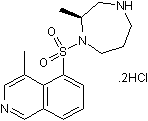H 1152 dihydrochloride
Chemical Name: (S)-(+)-2-Methyl-1-[(4-methyl-5-isoquinolinyl)sulfonyl]-hexahydro-1H-1,4-diazepine dihydrochloride
Purity: ≥98%
Biological Activity
H 1152 dihydrochloride is a rho-kinase (ROCK) inhibitor that displays high selectivity over other protein kinases (IC50 values are 0.012, 0.180, 0.360, 0.745, 3.03, 5.68 and 28.3 μM for ROCKII, CAMKII, PKG, Aurora A, PKA, PKC and MLCK respectively). Inhibits sulprostone-induced contractions in guinea pig aorta (IC50 = 190 nM) and displays proerectile effects in rats.Glycyl Derivative also available.
Technical Data
The technical data provided above is for guidance only.
For batch specific data refer to the Certificate of Analysis.
Tocris products are intended for laboratory research use only, unless stated otherwise.
Additional Information
Background References
-
Involvement of Rho-kinase in contraction of guinea-pig aorta induced by prostanoid EP3 receptor agonist.
Shum et al.
Br.J.Pharmacol., 2003;139:1449 -
Proerectile effects of the rho-kinase inhibitor (S)-(+)-2-methyl-1-[(4-methyl-5-isoquinolinyl)sulfonyl]homopiperazine (H-1152) in the rat penis.
Teixeira et al.
J.Pharmacol.Exp.Ther., 2005;315:155 -
Development of specific Rho-kinase inhibitors and their clinical application.
Tamura et al.
Biochim.Biophys.Acta, 2005;1754:245
Product Datasheets
Reconstitution Calculator
Molarity Calculator
Citations for H 1152 dihydrochloride
The citations listed below are publications that use Tocris products. Selected citations for H 1152 dihydrochloride include:
16 Citations: Showing 1 - 10
-
Tissue curvature and apicobasal mechanical tension imbalance instruct cancer morphogenesis.
Authors: Messal Et al.
Nature 2019;566:126
-
Rebalancing of actomyosin contractility enables mammary tumor formation upon loss of E-cadherin.
Authors: Schipper Et al.
Nat Commun 2019;10:3800
-
Sp1-regulated expression of p11 contributes to motor neuron degeneration by membrane insertion of TASK1.
Authors: García-Morales Et al.
Nat Commun 2019;10:3784
-
Rho-Kinase Inhibition Reduces Myofibroblast Differentiation and Proliferation of Scleral Fibroblasts Induced by Transforming Growth Factor β and Experimental Glaucoma.
Authors: Pitha Et al.
Transl Vis Sci Technol 2018;7:6
-
Rho Kinase Inhibition by AT13148 Blocks Pancreatic Ductal Adenocarcinoma Invasion and Tumor Growth.
Authors: Rath Et al.
Cancer Res 2018;78:3321
-
Expanding Actin Rings Zipper the Mouse Embryo for Blastocyst Formation.
Authors: Zenker Et al.
Cell 2018;173:776
-
ROCK signaling promotes collagen remodeling to facilitate invasive pancreatic ductal adenocarcinoma tumor cell growth.
Authors: Rath Et al.
EMBO Mol Med 2017;9:198
-
Oncogenic PIK3CA induces centrosome amplification and tolerance to genome doubling.
Authors: Berenjeno Et al.
Nat Commun 2017;8:1773
-
Multiparametric Analysis of Cell Shape Demonstrates that β-PIX Directly Couples YAP Activation to Extracellular Matrix Adhesion.
Authors: Sero and Bakal
Cell Syst 2017;4:84
-
RhoD Inhibits RhoC-ROCK-Dependent Cell Contraction via PAK6.
Authors: Durkin Et al.
Dev Cell 2017;41:315
-
Anoctamin 6 Contributes to Cl- Secretion in Accessory Cholera Enterotoxin (Ace)-stimulated Diarrhea: AN ESSENTIAL ROLE FOR PHOSPHATIDYLINOSITOL 4,5-BISPHOSPHATE (PIP2) SIGNALING IN CHOLERA.
Authors: Aoun Et al.
J Biol Chem 2016;291:26816
-
Cell shape and the microenvironment regulate nuclear translocation of NF-κB in breast epithelial and tumor cells.
Authors: Sero Et al.
Mol Syst Biol 2015;11:790
-
Cell shape and the microenvironment regulate nuclear translocation of NF-κB in breast epithelial and tumor cells.
Authors: Sero Et al.
Mol Syst Biol 2015;11:790
-
Activation of RhoA,B,C by Yersinia Cytotoxic Necrotizing Factor (CNFy) induces apoptosis in LNCaP prostate cancer cells.
Authors: Augspach Et al.
Toxins (Basel) 2013;5:2241
-
Roco kinase structures give insights into the mechanism of Parkinson disease-related leucine-rich-repeat kinase 2 mutations.
Authors: Gilsbach Et al.
Proc Natl Acad Sci U S A 2012;109:10322
-
Cytoskeletal changes underlie estrogen's acute effects on synaptic transmission and plasticity.
Authors: Kramár Et al.
J Clin Pharmacol 2009;29:12982
FAQs
No product specific FAQs exist for this product, however you may
View all Small Molecule FAQsReviews for H 1152 dihydrochloride
Average Rating: 4.7 (Based on 3 Reviews)
Have you used H 1152 dihydrochloride?
Submit a review and receive an Amazon gift card.
$25/€18/£15/$25CAN/¥75 Yuan/¥2500 Yen for a review with an image
$10/€7/£6/$10 CAD/¥70 Yuan/¥1110 Yen for a review without an image
Filter by:
Different Concentration were tested in vitro and lysates were collected.
Dihydrochloride were added at different time points to collect RNA and lysates
DMSO, 1uM and 10 μM H1152 dihydrochloride were added to cells for 24h for western.

